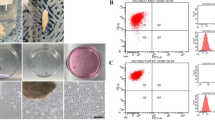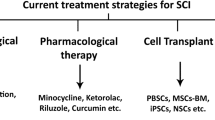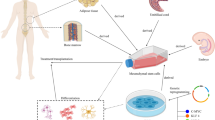Abstract
In the past decades, mesenchymal stem cells (MSCs) as a promising cell candidate have received the most attention in the treatment of spinal cord injury (SCI). However, due to the low survival rate and low neural differentiation rate, the grafted MSCs do not perform well as one would have expected. In the present study, we tested a combinational therapy to improve on this situation. MSCs were loaded into three-dimensional gelatin sponge (GS) scaffold. After 7 days of induction with neurotrophin-3 (NT-3) and retinoic acid (RA) in vitro, we observed a significant increase in TrkC mRNA transcription by Real-time PCR and this was confirmed by in situ hybridization. The expression of TrkC was also confirmed by Western blot and immunohistochemistry. Differentiation potential of MSCs in vitro into neuron-like cells or oligodendrocyte-like cells was further demonstrated by using immunofluorescence staining. The pre-induced MSCs seeding in GS scaffolds were then grafted into the transected rat spinal cord. One day after grafting, Governor Vessel electro-acupuncture (GV-EA) treatment was applied to rats in the NR-MSCs + EA group. At 30 days after GV-EA treatment, it found that the grafted MSCs have better survival rate and neuron-like cell differentiation compared with those without GV-EA treatment. The sustained TrkC expression in the grafted MSCs as well as increased NT-3 content in the injury/graft site by GV-EA suggests that NT-3/TrkC signaling pathway may be involved in the promoting effect. This study demonstrates that GV-EA and pre-induction with NT-3 and RA together may promote the survival and differentiation of grafted MSCs in GS scaffold in rat SCI.






Similar content being viewed by others
References
Binan, L., Ajji, A., De Crescenzo, G., Jolicoeur, M. (2013). Approaches for Neural Tissue Regeneration. Stem Cell Rev, 10(1), 44-59.
Rowland, J. W., Hawryluk, G. W., Kwon, B., & Fehlings, M. G. (2008). Current status of acute spinal cord injury pathophysiology and emerging therapies: promise on the horizon. Neurosurgical Focus, 25(5), E2.
Rodriguez, R., Garcia-Castro, J., Trigueros, C., et al. (2012). Multipotent mesenchymal stromal cells: clinical applications and cancer modeling. Advances in Experimental Medicine and Biology, 741(1), 187–205.
Han, Z., Jing, Y., Zhang, S., et al. (2012). The role of immunosuppression of mesenchymal stem cells in tissue repair and tumor growth. Cell Biosci, 2(1), 8.
Jung, D. I., Ha, J., Kang, B. T., et al. (2009). A comparison of autologous and allogenic bone marrow-derived mesenchymal stem cell transplantation in canine spinal cord injury. Journal of Neurological Sciences, 285(1–2), 67–77.
Kim, K. N., Oh, S. H., Lee, K. H., & Yoon, D. H. (2006). Effect of human mesenchymal stem cell transplantation combined with growth factor infusion in the repair of injured spinal cord. Acta Neurochirurgica. Supplement, 99(1), 133–136.
Sykova, E., & Jendelova, P. (2005). Magnetic resonance tracking of implanted adult and embryonic stem cells in injured brain and spinal cord. Annals of the New York Academy of Sciences, 1049(1), 146–160.
Deng, Y. B., Yuan, Q. T., Liu, X. G., et al. (2005). Functional recovery after rhesus monkey spinal cord injury by transplantation of bone marrow mesenchymal-stem cell-derived neurons. Chinese Medical Journal, 118(18), 1533–1541.
Lim, J. H., Byeon, Y. E., Ryu, H. H., et al. (2007). Transplantation of canine umbilical cord blood-derived mesenchymal stem cells in experimentally induced spinal cord injured dogs. Journal of Veterinary Science, 8(3), 275–282.
Karamouzian, S., Nematollahi-Mahani, S. N., Nakhaee, N., & Eskandary, H. (2012). Clinical safety and primary efficacy of bone marrow mesenchymal cell transplantation in subacute spinal cord injured patients. Clinical Neurology and Neurosurgery, 114(7), 935–939.
Alexanian, A. R., Maiman, D. J., Kurpad, S. N., & Gennarelli, T. A. (2008). In vitro and in vivo characterization of neurally modified mesenchymal stem cells induced by epigenetic modifiers and neural stem cell environment. Stem Cells and Development, 17(6), 1123–1130.
Keilhoff, G., Stang, F., Goihl, A., et al. (2006). Transdifferentiated mesenchymal stem cells as alternative therapy in supporting nerve regeneration and myelination. Cellular and Molecular Neurobiology, 26(7–8), 1235–1252.
Alexanian, A. R., Kwok, W. M., Pravdic, D., et al. (2010). Survival of neurally induced mesenchymal cells may determine degree of motor recovery in injured spinal cord rats. Restorative Neurology and Neuroscience, 28(6), 761–767.
Cao, Q. L., Zhang, Y. P., Howard, R. M., et al. (2001). Pluripotent stem cells engrafted into the normal or lesioned adult rat spinal cord are restricted to a glial lineage. Experimental Neurology, 167(1), 48–58.
Bain, G., Kitchens, D., Yao, M., et al. (1995). Embryonic stem cells express neuronal properties in vitro. Developmental Biology, 168(2), 342–357.
Takahashi, J., Palmer, T. D., & Gage, F. H. (1999). Retinoic acid and neurotrophins collaborate to regulate neurogenesis in adult-derived neural stem cell cultures. Journal of Neurobiology, 38(1), 65–81.
Zhang, W., Zeng, Y. S., Wang, J. M., et al. (2009). Neurotrophin-3 improves retinoic acid-induced neural differentiation of skin-derived precursors through a p75NTR-dependent signaling pathway. Neuroscience Research, 64(2), 170–176.
Greco, S. J., Zhou, C., Ye, J. H., & Rameshwar, P. (2008). A method to generate human mesenchymal stem cell-derived neurons which express and are excited by multiple neurotransmitters. Biol Proced Online, 10(1), 90–101.
Jin, K., Mao, X. O., Batteur, S., et al. (2003). Induction of neuronal markers in bone marrow cells: differential effects of growth factors and patterns of intracellular expression. Experimental Neurology, 184(1), 78–89.
Zhang, W., Zeng, Y. S., Zhang, X. B., et al. (2006). Combination of adenoviral vector-mediated neurotrophin-3 gene transfer and retinoic acid promotes adult bone marrow cells to differentiate into neuronal phenotypes. Neuroscience Letters, 408(2), 98–103.
O'Connor, S. M., Stenger, D. A., Shaffer, K. M., & Ma, W. (2001). Survival and neurite outgrowth of rat cortical neurons in three-dimensional agarose and collagen gel matrices. Neuroscience Letters, 304(3), 189–193.
Wang, L.-S., Chung, J. E., Pui-Yik Chan, P., & Kurisawa, M. (2010). Injectable biodegradable hydrogels with tunable mechanical properties for the stimulation of neurogenesic differentiation of human mesenchymal stem cells in 3D culture. Biomaterials, 31(6), 1148–1157.
Zeng, X., Zeng, Y. S., Ma, Y. H., et al. (2011). Bone marrow mesenchymal stem cells in a three-dimensional gelatin sponge scaffold attenuate inflammation, promote angiogenesis, and reduce cavity formation in experimental spinal cord injury. Cell Transplantation, 20(11–12), 1881–1899.
Schnell, M. A., Zhang, Y., Tazelaar, J., et al. (2001). Activation of innate immunity in nonhuman primates following intra portal administration of adenoviral vectors. Molecular Therapy, 3(5 Pt 1), 708–722.
Gonin, P., Buchholz, C. J., Pallardy, M., & Mezzina, M. (2005). Gene therapy bio-safety: scientific and regulatory issues. Gene Therapy, 12, 146–152.
Chen, Y. Y., Zhang, W., Chen, Y. L., et al. (2008). Electro-acupuncture improves survival and migration of transplanted neural stem cells in injured spinal cord in rats. Acupuncture and Electro-Therapeutics Research, 33(1–2), 19–31.
Wu, Y., Sun, Z., Li, Z., et al. (2002). Effect of acupuncture on free radicals in rats with early experimental spinal cord injury. Journal of Traditional Chinese Medicine, 22(1), 51–54.
Xie, J., Fang, J., Feng, X., & Liu, Q. (2006). Effect of electro acupuncture at acupoints of the governor vessel on aquaporin-4 in rat with experimental spinal cord injury. Journal of Traditional Chinese Medicine, 26(2), 148–152.
Wang, J. Q., & Liu, Z. S. (2008). Survey of acupuncture treatment for neurogenic bladder dysfunction after spinal cord injuries. Zhongguo Zhen Jiu, 28(10), 779–782.
Dorsher, P. T., & McIntosh, P. M. (2011). Acupuncture’s effects in treating the sequelae of acute and chronic spinal cord injuries: a review of allopathic and traditional Chinese medicine literature. Evidence-based Complementary and Alternative Medicine, 2011(1), 428108.
Liu, H., Yang, K., Xin, T., et al. (2012). Implanted electro-acupuncture electric stimulation improves outcome of stem cells’ transplantation in spinal cord injury. Artificial Cells, Blood Substitutes, and Immobilization Biotechnology, 40(5), 331–337.
Ding, Y., Yan, Q., Ruan, J. W., et al. (2009). Electro-acupuncture promotes survival, differentiation of the bone marrow mesenchymal stem cells as well as functional recovery in the spinal cord-transected rats. BMC Neuroscience, 10(1), 35.
Osaka, M., Honmou, O., Murakami, T., et al. (2010). Intravenous administration of mesenchymal stem cells derived from bone marrow after contusive spinal cord injury improves functional outcome. Brain research, 1343226-235
Ryu, H.-H., Lim, J.-H., Byeon, Y.-E., et al. (2009). Functional recovery and neural differentiation after transplantation of allogenic adipose-derived stem cells in a canine model of acute spinal cord injury. Journal of Veterinary Science, 10(4), 273–284.
Parr, A., Tator, C., & Keating, A. (2007). Bone marrow-derived mesenchymal stromal cells for the repair of central nervous system injury. Bone Marrow Transplantation, 40(7), 609–619.
Du, B. L., Zeng, C. G., Zhang, W., et al. (2014). A comparative study of gelatin sponge scaffolds and PLGA scaffolds transplanted to completely transected spinal cord of rat. J Biomed Mater Res A 102(6):1715-1725.
Huang, E. J., & Reichardt, L. F. (2003). Trk receptors: roles in neuronal signal transduction. Annual Review of Biochemistry, 72(1), 609–642.
Segal, R. A. (2003). Selectivity in neurotrophin signaling: theme and variations. Annual Review of Neuroscience, 26(1), 299–330.
Kumagai, G., Tsoulfas, P., Toh, S., et al. (2013). Genetically modified mesenchymal stem cells (MSCs) promote axonal regeneration and prevent hypersensitivity after spinal cord injury. Experimental Neurology, 248(1), 369–380.
Zhang, Y. Q., He, L. M., Xing, B., et al. (2012). Neurotrophin-3 gene-modified Schwann cells promote TrkC gene-modified mesenchymal stem cells to differentiate into neuron-like cells in poly (lactic-acid-co-glycolic acid) multiple-channel conduit. Cells, Tissues, Organs, 195(4), 313–322.
Chen, G., Lv, Y., Guo, P., et al. (2013). Matrix mechanics and fluid shear stress control stem cells fate in three dimensional microenvironment. Current Stem Cell Research & Therapy, 8(4), 313–323.
Pek, Y. S., Wan, A. C., & Ying, J. Y. (2010). The effect of matrix stiffness on mesenchymal stem cell differentiation in a 3D thixotropic gel. Biomaterials, 31(3), 385–391.
Pevsner-Fischer, M., Levin, S., & Zipori, D. (2011). The origins of mesenchymal stromal cell heterogeneity. Stem Cell Reviews, 7(3), 560–568.
Lei, J., Hui, D., Huang, W., et al. (2013). Heterogeneity of the biological properties and gene expression profiles of murine bone marrow stromal cells. International Journal of Biochemistry and Cell Biology, 45(11), 2431–2443.
Oh, J. S., Ha, Y., An, S. S., et al. (2010). Hypoxia-preconditioned adipose tissue-derived mesenchymal stem cell increase the survival and gene expression of engineered neural stem cells in a spinal cord injury model. Neuroscience Letters, 472(3), 215–219.
Menn, B., Timsit, S., Represa, A., et al. (2000). Spatiotemporal expression of noncatalytic TrkC NC2 isoform during early and late CNS neurogenesis: a comparative study with TrkC catalytic and p75NTR receptors. European Journal of Neuroscience, 12(9), 3211–3223.
Peng, B., Meng, X. F., Li, M., et al. (2007). Effects of electro acupuncture on the expression of epidermal growth factor receptor and glial fibrillary acidic protein after spinal cord injury in rats. Zhen Ci Yan Jiu, 32(4), 219–223.
Yang, C., Li, B., Liu, T. S., et al. (2005). Effect of electro acupuncture on proliferation of astrocytes after spinal cord injury. Zhongguo Zhen Jiu, 25(8), 569–572.
Chopp, M., Zhang, X. H., Li, Y., et al. (2000). Spinal cord injury in rat: treatment with bone marrow stromal cell transplantation. Neuroreport, 11(13), 3001–3005.
Satake, K., Lou, J., & Lenke, L. G. (2004). Migration of mesenchymal stem cells through cerebrospinal fluid into injured spinal cord tissue. Spine (Phila Pa 1976), 29(18), 1971–1979.
Arevalo, J. C., & Wu, S. H. (2006). Neurotrophin signaling: many exciting surprises! Cellular and Molecular Life Sciences, 63(13), 1523–1537.
Ichim, G., Tauszig-Delamasure, S., & Mehlen, P. (2012). Neurotrophins and cell death. Experimental Cell Research, 318(11), 1221–1228.
Wang, T.-H., Wang, X.-Y., Li, X.-L., et al. (2007). Effect of electro acupuncture on neurotrophin expression in cat spinal cord after partial dorsal rhizotomy. Neurochemical Research, 32(8), 1415–1422.
Chen, J., Qi, J.-G., Zhang, W., et al. (2007). Electro-acupuncture induced NGF, BDNF and NT-3 expression in spared L6 dorsal root ganglion in cats subjected to removal of adjacent ganglia. Neuroscience Research, 59(4), 399–405.
Huang, S.-F., Ding, Y., Ruan, J.-W., et al. (2011). An experimental electro-acupuncture study in treatment of the rat de myelinated spinal cord injury induced by ethidium bromide. Neuroscience Research, 70(3), 294–304.
Patel, N. B., & Poo, M.-M. (1984). Perturbation of the direction of neurite growth by pulsed and focal electric fields. The Journal of Neuroscience, 4(12), 2939–2947.
Patel, N. B., Poo, M.-M. (1984). Perturbation of the direction of neurite growth by pulsed and focal electric fields. The Journal of Neuroscience, 4(12), 2939--2947.
Cooper, D. M., Mons, N., Karpen, J. W. (1995). Adenylyl cyclases and the interaction between calcium and cAMP signalling. Nature, 374(6521), 421--424.
Hansen, M. R., Zha, X.-M., Bok, J., & Green, S. H. (2001). Multiple distinct signal pathways, including an autocrine neurotrophic mechanism, contribute to the survival-promoting effect of depolarization on spiral ganglion neurons in vitro. The Journal of Neuroscience, 21(7), 2256–2267.
Kolarow, R., Brigadski, T., & Lessmann, V. (2007). Postsynaptic secretion of BDNF and NT-3 from hippocampal neurons depends on calcium–calmodulin kinase II signaling and proceeds via delayed fusion pore opening. The Journal of Neuroscience, 27(39), 10350–10364.
Li, W.-J., Li, S.-M., Ding, Y., et al. (2012). Electro-acupuncture upregulates CGRP expression after rat spinal cord transection. Neurochemistry International, 61(8), 1397–1403.
Corbett, G. T., Roy, A., & Pahan, K. (2013). Sodium phenylbutyrate enhances Astrocytic neurotrophin synthesis via protein kinase C (PKC)-mediated activation of cAMP-response element-binding protein (CREB) IMPLICATIONS FOR ALZHEIMER DISEASE THERAPY. Journal of Biological Chemistry, 288(12), 8299–8312.
Kay, J. C., Xia, C.-M., Liu, M., et al. (2013). Endogenous PI3K/Akt and NMDAR act independently in the regulation of CREB activity in lumbosacral spinal cord in cystitis. Experimental neurology, 250366-375
Ding, Y., Yan, Q., Ruan, J. W., et al. (2013). Electroacupuncture promotes the differentiation of transplanted bone marrow mesenchymal stem cells overexpressing TrkC into neuron-like cells in transected spinal cord of rats. Cell Transplantation, 22(1), 65–86.
Farhadi, H. F., Mowla, S. J., Petrecca, K., et al. (2000). Neurotrophin-3 sorts to the constitutive secretory pathway of hippocampal neurons and is diverted to the regulated secretory pathway by coexpression with brain-derived neurotrophic factor. The Journal of Neuroscience, 20(11), 4059–4068.
Klopotowska, D., & Strzadala, L. (2005). The role of TrkC receptor and neurotrophin 3 in the development and function of neural cells. Postepy Higieny i Medycyny Doświadczalnej (Online), 59(1), 517–522.
Acknowledgments
This study was supported by grants from the Chinese National Natural Science Foundation (No. 81330028; U1301223), National 863 Project (No. 2013AA020106), Foundation of the Education Ministry of China (201300193035), Foundation of Guangdong Province (No. 2011A030300004), and Foundation of Guangzhou City (No. 2012 J4100077) to Y.S. Zeng.
Conflict of Interest
The authors declare no potential conflicts of interest.
Author information
Authors and Affiliations
Corresponding author
Rights and permissions
About this article
Cite this article
Zhang, K., Liu, Z., Li, G. et al. Electro-Acupuncture Promotes the Survival and Differentiation of Transplanted Bone Marrow Mesenchymal Stem Cells Pre-Induced with Neurotrophin-3 and Retinoic Acid in Gelatin Sponge Scaffold after Rat Spinal Cord Transection. Stem Cell Rev and Rep 10, 612–625 (2014). https://doi.org/10.1007/s12015-014-9513-4
Published:
Issue Date:
DOI: https://doi.org/10.1007/s12015-014-9513-4




